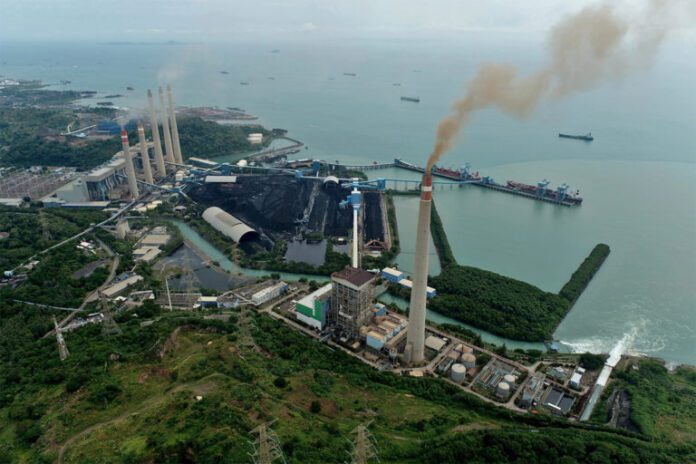- Indonesia burned 33% additional coal in 2022 than the 12 months sooner than, contributing to a 20% elevate within the nation’s carbon emissions from fossil fuels, an prognosis of dependable recordsdata reveals.
- This is able to possible catapult Indonesia to vary into the realm’s sixth-absolute finest fossil CO2 emitter, slack Japan, per the prognosis.
- This rise in coal burning aligns with efforts to rob financial restoration following the COVID-19 pandemic, in conjunction with the slate of most modern coal-fired vitality vegetation that presently received proper right here on-line as efficiently as a result of the expansion of the nickel business.
- Industrial parks which can almost definitely be home to smelters processing nickel and numerous metals make use of 15% of the nation’s coal vitality output.
JAKARTA — Indonesia burned additional coal in 2022 than any numerous 12 months, a preliminary prognosis reveals, putting the nation on course to vary into one in all many excellent carbon emitters from fossil gasoline on this planet.
Knowledge from the Indonesian Ministry of Vitality and Mineral Sources confirmed that coal consumption amounted to 745.72 million barrels of oil equal (BOE) in 2022, a 33% elevate from 558.78 million BOE in 2021.
The data reveals the nation’s coal consumption to be top-of-the-line ever by a truly mighty margin.

The make use of of this recordsdata, researchers from the World Carbon Mission, an organization that seeks to quantify international greenhouse gasoline emissions and their sources, measured the emissions that received proper right here from that elevate.
Coupled with numerous will increase in fossil gasoline consumption, much like oil (12%) and gasoline (1.2%), these will increase drove Indonesia’s complete carbon dioxide equal (CO2e) emissions from fossil fuels to develop by 20.3%, per Robbie Andrew, a member of the World Carbon Mission and senior researcher on the Norway-essentially primarily based CICERO Centre for World Native local weather Analysis.

That save Indonesia’s complete CO2e emissions from burning fossil fuels at 619 million metric tons, with Andrew describing each the narrate in coal consumption and emissions as “sturdy” and “enormous.”
“Not one of the realm’s top-ten excellent emitters has thought-about narrate of 20% within the closing 15 years,” Andrew advised Mongabay.
In 2021, Indonesia’s emissions from fossil fuels had been the ninth excellent on this planet, per recordsdata from the World Carbon Mission.
With the elevate in its fossil gasoline emissions, Indonesia has grow to be the realm’s sixth-absolute finest fossil CO2 emitter, slack Japan, Andrew acknowledged.
The make use of of preliminary recordsdata, Indonesia’s fossil gasoline emissions is estimated to surpass these of Saudi Arabia, Iran and Germany.
“Nonetheless, Indonesia is handiest very marginally earlier than Saudi Arabia and Iran: all three worldwide places think about regards to the identical emissions, nonetheless our estimates level out Indonesia absolute better of the three on account of of its mighty elevate,” Andrew acknowledged. “The sharp ask may maybe be what occurs in 2023. If Indonesia grows sharply once more in 2023, then this may perchance additionally doubtlessly traipse additional clearly into sixth set up.”
The Ministry of Ambiance and Forestry’s native local weather change division did not retort to Mongabay’s inquire of for remark.
Whereas Indonesia’s fossil gasoline emissions had elevated sharply, its fossil gasoline emissions per capita, at 2.7 tonnes, is level-headed nice lower than that of the U.S, at 15 tonnes.

Emissions targets undermined
This rise in coal burning is fueled by efforts to rob financial restoration following the COVID-19 pandemic, in conjunction with the slate of most modern coal-fired vitality vegetation that presently received proper right here on-line as efficiently as a result of the development of the nickel business — a strategic priority for the govtas it seems to be wish to reveal itself within the worldwide present chain for the batteries powering electrical autos and numerous inexperienced skills.
Indonesia is already the realm’s third-perfect coal producer and a foremost coal specific particular person as efficiently. That consumption will proceed to rise through 2029 as novel coal vegetation proceed to be constructed and traipse browsing, per the Institute for Wished Services Reform (IESR), a coverage state tank primarily primarily based in Jakarta.
One other disclose is the dearth of efforts to fragment out and even uninteresting down coal mining, no topic the govts acknowledged ambitions of accomplishing earn-zero emissions by 2060. Grita Anindarini, program director on the Indonesian Middle for Environmental Laws (ICEL), noteworthy that the govtis as a change focusing on an elevate of as regards to 5% in coal manufacturing this 12 months.
If Indonesia’s coal consumption continues to rise, so will its emissions from burning fossil fuels, acknowledged IESR govt director Fabby Tumiwa. And this, he acknowledged, will jeopardize Indonesia’s goal of getting its emissions from the vitality sector peak in 2030.
That highlight on is a fraction of Indonesia’s elevated ambition to transition from fossil fuels to renewable vitality and is enshrined in a historic deal struck in November 2022. Beneath that deal, recognized as a result of the Real Vitality Transition Partnership (JETP), the G7 neighborhood of industrialized worldwide places, plus Denmark and Norway, agreed to supply $20 billion in funding to Indonesia to help it creep up its vitality transition.
Consultants voice Indonesia’s vitality transition agenda is very principal for the worldwide goal of limiting temperature rise to 1.5° Celsius (2.7° Fahrenheit) above pre-industrial levels, as a result of the nation is among the many realm’s excellent emitters.
The JETP funding is meant to help Indonesia cap its emissions from the facility sector at 290 million metric tons by 2030, sooner than its preliminary goal of 2037. That’s speculated to be accomplished by retiring current coal-fired vitality vegetation and freezing novel vitality plant tasks.
However when the amount of coal being burned continues to rise, “then our emission cap goal in 2030 may maybe be partaking to sort,” Fabby advised Mongabay.
“The additional partaking it is, the elevated the mitigation payment may maybe be. If that’s the case, we’re ready to’t lower our emissions [as it’s too expensive]. So our emissions will proceed to rise,” he acknowledged, warning of a vicious cycle.

Burning additional coal to assemble up
As factories slowed their manufacturing in the way forward for the COVID-19 pandemic, vitality consumption went down. The continuing restoration has thought-about a velocity to manufacture up for this downtime.
“Coal consumption truly grew sharply within the two years sooner than the pandemic, so the narrate in 2022 is partly about restoration to Indonesia’s outdated narrate trajectory,” Andrew acknowledged.
That spirited elevate pre-pandemic may perchance moreover be attributed to completely completely different most modern coal vegetation that received proper right here on-line in most modern years, Fabby acknowledged. These are fragment of President Joko Widodo’s flagship program of including 35 gigawatts (GW) to the nationwide grid in a command to vitality Indonesia’s financial system, top-of-the-line in Southeast Asia and the 17th excellent on this planet by GDP.
This system entails the constructing of a whole lot of vitality vegetation of assorted sorts. However the majority of the additional functionality, 20 GW, will come from 117 coal vegetation.
In 2015, when the 35 GW program became as quickly as supplied, Indonesia’s snappy of current coal vegetation had a blended functionality of 25.4 GW. In 2022, that had elevated by 60% to 40.6 GW, per a 2023 itemizing by World Vitality Visible present unit.
So a spirited publish-pandemic elevate to assemble as rather a lot because the pre-pandemic stage of coal burning is to be anticipated, Fabby acknowledged.
“Many novel coal vegetation began working from 2019, so there’s a tall elevate,” he acknowledged.
One other key goal is the rising ask for coal within the metals business. That’s easy from numerous principal points within the vitality ministry recordsdata, per Andrew, with nice of the elevate pushed by Indonesia’s nickel business.


Fueling the nickel dream
Indonesia is the realm’s excellent producer of nickel, a key part within the lithium-ion batteries broken-down in EVs and renewable vitality storage. The Widodo govt is banking on the nation’s nickel reserves — estimated at a pair of quarter of the worldwide complete — to flip the nation into an EV powerhouse.
Indonesia’s nickel manufacturing rose by 60% in 2022, accounting for half of of world manufacturing. However this inexperienced ambition comes with a neighborhood local weather toll, supplied that the nickel business is massively vitality intensive. And in Indonesia, the facility grid is dominated by coal.
In 2022, 43% of Indonesia’s electrical energy received proper right here from coal, an all-time extreme, whereas renewable accounted for proper 10% of the vitality mix.
“In Indonesia … the carbon per kilowatt-hour of vitality technology is rather a lot elevated than fairly a great deal of the rest of the realm,” Andrew Digges, Asia affiliate at international regulation agency Norton Rose Fulbright, acknowledged as quoted within the Monetary Cases in September 2022. “If we evaluate to Canada … Indonesia will, by 2030, produce about eight or 9 situations as nice carbon per kilowatt-hour of electrical energy as Canada will.”
Indonesia’s industrial parks, notably these on the islands of Sulawesi and Halmahera which have religion grow to be foremost hubs for nickel and aluminum processing, are additionally closely reliant on coal. They make use of 15% of the nation’s coal vitality output.
Furthermore, Indonesia’s nickel reserves are the laterite ore sort, which require additional processing to vary into battery-grade nickel than does the sulfide ore got here all of the diagram by which through largely in Canada, Russia and Australia.
As a end result, making battery-grade nickel, additionally recognized as Class 1 nickel, in Indonesia is rather a lot additional carbon-intensive than someplace else; producing Class 1 nickel from Indonesia’s laterite ore assets releases two to 6 situations the amount of CO2 emissions as producing Class 1 nickel from sulfide deposits.

Held captive by coal vegetation
The rise in coal consumption comes as novel smelters to course of nickel and numerous metals spring up all of the diagram by which through the nation. Building on all these began in 2017 and 2018, and with operations initiating connect in 2019 onward, per Fabby.
To vitality these smelters, coal-fired electrical energy vegetation are constructed notably to serve them, recognized as captive vegetation. By definitions, on account of this fact, these are vegetation that may’t be shut down with out shutting down the industries that they vitality, Fabby acknowledged.
“In the event that they’re shut down, the smelters may even crease operation on account of there’s no alternative [power source] however,” he acknowledged. “It’s not easy to vary them on account of there’s a should plan novel infrastructure. So technically and economically talking, it’s not easy.”
He known as on the govtand industries to stop constructing novel coal vegetation altogether, whether or not or not feeding into the nationwide grid or captive.
“As quickly as coal vegetation are constructed, it’s partaking to retire them sooner than their anticipated stop of age,” he acknowledged. “And it’ll be additional partaking and costlier to plan the infrastructure to vary them. So primarily essentially the most uncomplicated and least expensive risk is to not plan fossil gasoline infrastructure if there’s no want for them. Or if there are plans to plan them, smash and exchange them with renewable vitality in order that we’re ready to sort our emissions cap goal within the energy sector.”
Banner picture: The Suralaya coal-fired vitality plant in Indonesia. Picture courtesy of Vogue Asia.


